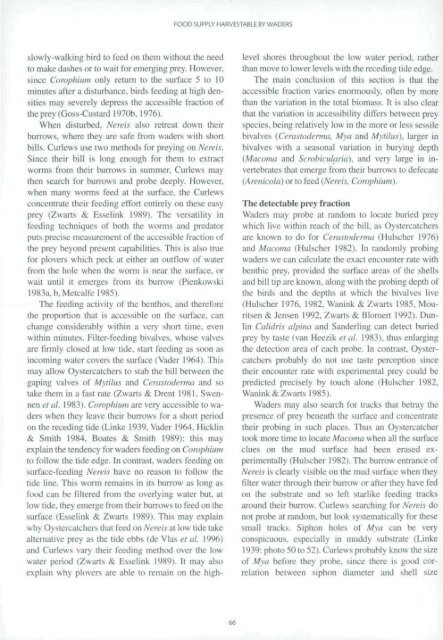waders and their estuarine food supplies - Vlaams Instituut voor de ...
waders and their estuarine food supplies - Vlaams Instituut voor de ...
waders and their estuarine food supplies - Vlaams Instituut voor de ...
You also want an ePaper? Increase the reach of your titles
YUMPU automatically turns print PDFs into web optimized ePapers that Google loves.
slowly-walking bird to feed on them without the need<br />
io make dashes or to wait for emerging prey. However,<br />
since Corophium only return to the surface 5 lo 10<br />
minutes after a disturbance, birds feeding at high <strong>de</strong>nsities<br />
may severely <strong>de</strong>press the accessible fraction of<br />
the prey (Goss-Custard 1970b. 1976).<br />
When disturbed. Nereis also retreat down <strong>their</strong><br />
burrows, where they are safe from <strong>wa<strong>de</strong>rs</strong> with short<br />
bills. Curlews use two methods for preying on Nereis.<br />
Since <strong>their</strong> bill is long enough for them to extract<br />
worms from <strong>their</strong> burrows in summer. Curlews may<br />
ihen search for burrows <strong>and</strong> probe <strong>de</strong>eply. However,<br />
when many worms feed at the surface, the Curlews<br />
concentrate <strong>their</strong> feeding effort entirely on these eas)<br />
prey (Zwarts & Esselink 1989). The versatility in<br />
feeding techniques of both the worms <strong>and</strong> predatoi<br />
puts precise measurement of the accessible fraction of<br />
the prey beyond present capabilities. This is also true<br />
for plovers which peck at either an outflow of water<br />
from the hole when the worm is near the surface, or<br />
wait until it emerges from its burrow (Pienkowski<br />
1983a. b. Metcalfe 1985).<br />
The feeding activity of the benthos, <strong>and</strong> therefore<br />
the proportion that is accessible on the surface, can<br />
change consi<strong>de</strong>rably within a very short time, even<br />
within minutes. Filter-feeding bivalves, whose valves<br />
are firmly closed at low ti<strong>de</strong>, start feeding as soon as<br />
incoming water covets the surface (Va<strong>de</strong>r 1964). This<br />
may allow Oystercatchers to stab the bill between the<br />
gaping valves of Mytilus <strong>and</strong> Cerasto<strong>de</strong>rma <strong>and</strong> so<br />
take them in a fast rate (Zwarts & Drent 1981. Swennen<br />
et al. 1983). Corophium are very accessible to <strong>wa<strong>de</strong>rs</strong><br />
when they leave <strong>their</strong> burrows for a short period<br />
on the receding ti<strong>de</strong> (Linke 1939. Va<strong>de</strong>r 1964. Hicklin<br />
& Smith 1984, Boates & Smith 1989): this may<br />
explain the ten<strong>de</strong>ncy for <strong>wa<strong>de</strong>rs</strong> feeding on Corophium<br />
to follow the ti<strong>de</strong> edge. In contrast, <strong>wa<strong>de</strong>rs</strong> feeding on<br />
surface-feeding Nereis have no reason to follow the<br />
ti<strong>de</strong> line. This worm remains in its burrow as long as<br />
<strong>food</strong> can be filtered from the overlying water but. at<br />
low ti<strong>de</strong>, they emerge from <strong>their</strong> burrows to feed on the<br />
surface (Esselink & Zwarts 1989). This may explain<br />
w h\ () v sieic .ik hei s that Iced on Nereis at low ti<strong>de</strong> take<br />
alternative prey as the ti<strong>de</strong> ebbs (<strong>de</strong> Vlas et al. 1996)<br />
<strong>and</strong> Curlews vary <strong>their</strong> feeding method over the low<br />
water period (Zwarts & Esselink 1989). Il mav also<br />
explain why plovers are able to remain on the high-<br />
FOOD SUPPLY HARVESTABLE BY WADERS<br />
66<br />
level shores throughout the low water period, rather<br />
than move to lower levels with the receding ti<strong>de</strong> edge.<br />
The main conclusion of this section is that the<br />
accessible fraction varies enormously, often by more<br />
than the variation in the total biomass. Il is also clear<br />
that the variation in accessibility differs between prey<br />
species, being relatively low in the more or less sessile<br />
bivalves 'Cerasto<strong>de</strong>rma, Mya <strong>and</strong> Mytilus). larger in<br />
bivalves with a seasonal variation in burying <strong>de</strong>pth<br />
(Macoma <strong>and</strong> Scrobicularia). <strong>and</strong> very large in invertebrates<br />
thai emerge from <strong>their</strong> burrows to <strong>de</strong>fecate<br />
(Arenicola) or Io feed (Nereis. Corophium).<br />
The <strong>de</strong>tectable prey fraction<br />
Wa<strong>de</strong>rs may probe at r<strong>and</strong>om to locate buried prey<br />
which live within reach of the bill, as Oystercatchers<br />
are known to do for Cerasto<strong>de</strong>rma (Hulscher 1976)<br />
<strong>and</strong> Macoma (Hulscher 1982). In r<strong>and</strong>omly probing<br />
<strong>wa<strong>de</strong>rs</strong> we can calculate the exact encounter rate with<br />
benthic prey, provi<strong>de</strong>d the surface areas of the shells<br />
<strong>and</strong> bill tip are known, along with the probing <strong>de</strong>pth of<br />
the birds <strong>and</strong> the <strong>de</strong>pths at which the bivalves live<br />
(Hulscher 1976. 1982. Wanink & Zwarts 1985. Mourilsen<br />
& Jensen 1992. Zwarts & Blomert 1992). Dunlin<br />
Calidris alpina <strong>and</strong> S<strong>and</strong>erling can <strong>de</strong>tect buried<br />
prey by taste (van Hee/.ik et al. 1983). thus enlarging<br />
the <strong>de</strong>tection area of each probe. In contrast. Oystercatchers<br />
probably do not use taste perception since<br />
<strong>their</strong> encounter rate wilh experimental prey could be<br />
predicted precisely by touch alone (Hulscher 1982.<br />
Wanink & Zwarts 1985).<br />
Wa<strong>de</strong>rs may also search for Hacks that betray the<br />
presence of pre) beneath the surface <strong>and</strong> concentrate<br />
<strong>their</strong> probing in such places. Thus an Oystercatcher<br />
look more time to locate Macoma when all Ihe surface<br />
clues on the mud surface had been erased experimentally<br />
(Hulscher 1982). The burrow entrance of<br />
Nereis is clearlv v tsible on the mud surface when they<br />
filter water through <strong>their</strong> burrow or after they have fed<br />
on the substrate <strong>and</strong> so left starlike feeding tracks<br />
around <strong>their</strong> burrow. Curlews searching for Nereis do<br />
not probe at r<strong>and</strong>om, but look systematically for these<br />
small tracks. Siphon holes of Mya can be very<br />
conspicuous, especially in muddy substrate (Linke<br />
1939: photo 50 to 52). Curlews probably know the size<br />
of Mya before they probe, since there is good correlation<br />
between siphon diameter <strong>and</strong> shell size

















